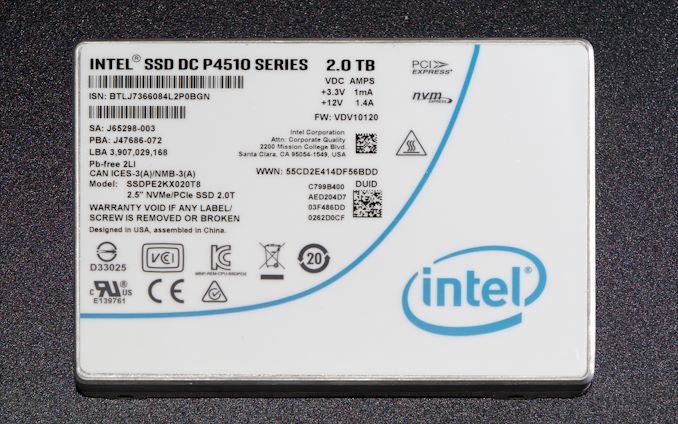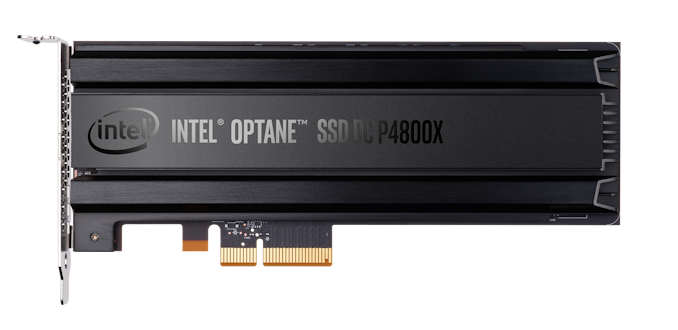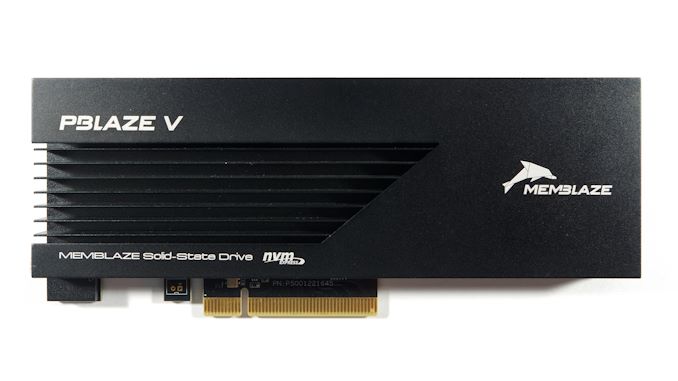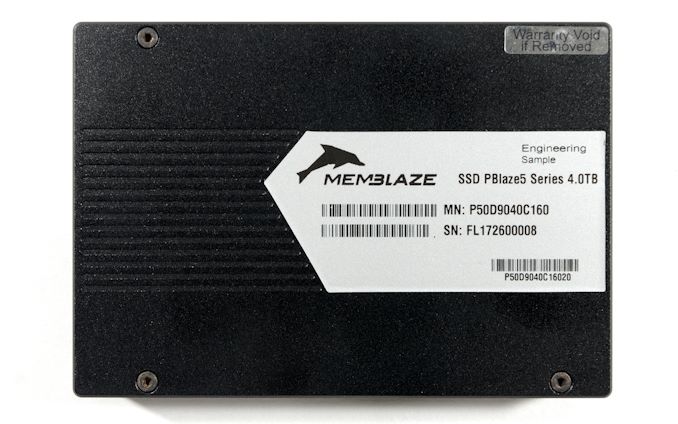The Enterpise TLC Storage Era Begins: Rounding Up 13 SSDs With Samsung, Intel, and Memblaze
by Billy Tallis on January 3, 2019 9:45 AM ESTIntel SSD DC P4510
When Intel launched the DC P4510 earlier this year, our initial review focused on using it to test out Intel's Virtual RAID on CPU (VROC) feature. Now, we're focusing on individual drive performance and adding in power efficiency testing that wasn't practical for multi-drive RAID configurations.
Since the P4510 launched, Intel has announced a new naming scheme for their enterprise SSDs. Their long-term plan is to push a combination of QLC drives for capacity and Optane drives for performance, but TLC drives like the P4510 aren't going away anytime soon and the P4510 is still a current-generation product.
The Intel P4510 is the middle tier of their enterprise NVMe drives with 64-layer 3D NAND. Below it sits the D5-P4320 QLC NAND SSD, and above it is the DC P4610. The Px700 product tier is empty this generation, with the P4610 pitched as the replacement for both the P4600 and the first-generation P3700. With the P4500 and P4600, Intel introduced their second-generation enterprise NVMe controller and paired it with their first-generation (32-layer) 3D NAND. The P4510 is an update to use the current 64-layer 3D TLC.
| Intel SSD DC P4510 Specifications | |||||
| Capacity | 1 TB | 2 TB | 4 TB | 8 TB | |
| Form Factor | 2.5" 15mm U.2 | ||||
| Interface | PCIe 3.1 x4 NVMe 1.2 | ||||
| Memory | Intel 512Gb 64-layer 3D TLC | ||||
| Sequential Read | 2850 MB/s | 3200 MB/s | 3000 MB/s | 3200 MB/s | |
| Sequential Write | 1100 MB/s | 2000 MB/s | 2900 MB/s | 3000 MB/s | |
| Random Read | 469k IOPS | 624k IOPS | 625.5k IOPS | 620k IOPS | |
| Random Write | 72k IOPS | 79k IOPS | 113.5k IOPS | 139.5k IOPS | |
| Maximum Power | Active | 10 W | 10 W | 14 W | 16 W |
| Idle | 5 W | 5 W | 5 W | 5 W | |
| Write Endurance | 1.1 DWPD | 0.7 DWPD | 0.9 DWPD | 1.0 DWPD | |
| Warranty | 5 years | ||||
With the P4510, we're finally starting to see performance specs that look comparable to high-end consumer SSDs, but unlike consumer drives the P4510 can be expected to maintain this performance indefinitely. The write endurance rating varies a bit with capacity, from a low of 0.7 DWPD up to 1.1 DWPD. Overall, this puts it in the same endurance class as the Samsung 983 ZET, but the P4510 is in a slightly higher class for performance and power consumption.
The P4510 uses a 15mm 2.5" U.2 form factor. Inside are two stacked PCBs, connected by a semi-flexible joint. The 12-channel controller and most of the DRAM are at the bottom of the drive, with thermal pads dissipating heat to the case's heatsink surface. The back side of the primary PCB has room for more DRAM (to enable the 8TB model) and a bit more NAND. But most of the NAND is on the secondary PCB, with 10 packages on each side. Due to the extra thickness of the 15mm form factor, a single large power loss protection capacitor is used instead of an array of smaller caps. The NAND and DRAM on the inner faces of the two PCBs do not get any airflow or thermal pads bridging them to the case. This lack of cooling is one of the major motivators of Intel's Ruler form factor, now standardized as EDSFF.
Intel Optane SSD DC P4800X
Intel's Optane SSD DC P4800X is the flagship model not just of Intel's SSD family, but the entire SSD market. Built around 3D XPoint memory instead of NAND flash, the Optane SSD sets the standard for low latency and high endurance. We first tested the 375GB model through remote access before the P4800X was ready for widespread release, then later reviewed the 750GB model hands-on. More recently, Intel has introduced a 1.5TB model and doubled the write endurance rating of new models to 60 DWPD.
| Intel Optane SSD DC P4800X Specifications | ||||
| Capacity | 375 GB | 750 GB | 1.5 TB | |
| Form Factor | PCIe HHHL or 2.5" 15mm U.2 | |||
| Interface | PCIe 3.0 x4 NVMe | |||
| Controller | Intel SLL3D | |||
| Memory | 128Gb 20nm Intel 3D XPoint | |||
| Typical Latency (R/W) | <10µs | |||
| Random Read (4 kB) IOPS (QD16) | 550,000 | |||
| Random Read 99.999% Latency (QD1) | 60µs | |||
| Random Read 99.999% Latency (QD16) | 150µs | |||
| Random Write (4 kB) IOPS (QD16) | 500,000 | |||
| Random Write 99.999% Latency (QD1) | 100µs | |||
| Random Write 99.999% Latency (QD16) | 200µs | |||
| Mixed 70/30 (4kB) Random IOPS (QD16) | 500,000 | |||
| Sequential Read (64kB) | 2400 MB/s | |||
| Sequential Write (64kB) | 2000 MB/s | |||
| Active Power | Read | 8 W | 10 W | 18 W |
| Write | 13 W | 15 W | ||
| Idle Power | 5 W | 6 W | 7 W | |
| Endurance | 30 DWPD | 60 DWPD | ||
| Warranty | 5 years | |||
Memblaze PBlaze5
Memblaze is not one of the biggest names in the SSD market, but they supplied two of the most powerful SSDs in this review. Memblaze is one of many companies that offer high-end enterprise SSDs but don't manufacture their own memory or controllers. Instead, Memblaze uses the most powerful SSD controllers available on the open market: the Flashtec NVMe product family that originated with IDT and was used in one of the first PCIe SSDs, and has changed hands several times since then in corporate acquisitions, to PMC-Sierra, Microsemi and now Microchip. Major players like Intel and Samsung have their own controller ASICs that can compete in this product segment, but most other companies either go for the Flashtec controllers or a big Xilinx FPGA. Familiar controller vendors like Marvell and Silicon Motion have been eying this market segment, but so far they are only offering solutions that more or less pair up two of their smaller 8-channel controllers, rather than monolithic 16 or 32-channel controller designs.
The PBlaze5 900 series SSDs use the Flashtec NVMe2016 controller that provides 16 channels for NAND and up to 8 PCIe lanes for the host interface. The PBlaze D900 is the U.2 version and supports operating with either a PCIe 3.0 x4 host interface or in dual-port x2+x2 mode when used in a system with PCIe fabric switches that support redundant multipath connections. For our testing, the D900 has a direct PCIe x4 connection to one of the test system's CPUs.
| Memblaze PBlaze5 Series Specifications | |||||||||
| PBlaze5 D900 | PBlaze5 C900 | ||||||||
| Form Factor | 2.5" 15mm U.2 | HHHL AIC | |||||||
| Interface | PCIe 3.0 x4 | PCIe 3.0 x8 | |||||||
| Controller | Microsemi Flashtec PM8607 NVMe2016 | ||||||||
| Protocol | NVMe 1.2a | ||||||||
| NAND | Micron 384Gb 32L 3D TLC | ||||||||
| Capacities (TB) | 2 TB | 3.2 TB | 4 TB | 8 TB | 2 TB | 3.2 TB | 4 TB | 8 TB | |
| Sequential Read (GB/s) | 3.5 | 5.3 | 6.0 | 5.9 | 5.5 | ||||
| Sequential Write (GB/s) | 2.2 | 3.2 | 3.4 | 3.5 | 2.2 | 3.2 | 3.8 | 3.8 | |
| Random Read (4 kB) IOPS | 825k | 835k | 823k | 1005k | 1010k | 1001k | |||
| Random Write (4 kB) IOPS | 255k | 280k | 347k | 328k | 235k | 288k | 335k | 348k | |
| Latency Read (4kB) | 94 µs | 93 µs | |||||||
| Latency Write | 16 µs | 15 µs | |||||||
| Power | Idle | 7 W | |||||||
| Operating | 25 W | ||||||||
| Endurance | 3 DWPD | ||||||||
| Warranty | Five years | ||||||||
The PBlaze5 C900 is a half-height half-length add-in card with a PCIe x8 connection, giving it the possibility of providing more than 4GB/s—our 4TB sample is rated for 5.9GB/s sequential reads, and slightly over 1M random read IOPS.
The PBlaze5 900-series uses Micron's 32-layer 3D TLC NAND. The somewhat awkward 384Gb per-die capacity lends itself well to building a drive with large overprovisioning: these 4TB drives have 6TiB of NAND onboard, plenty to enable a 3 DWPD endurance rating and support very high performance despite the older and slower 3D NAND. Memblaze has also introduced newer PBlaze5 models that move to Micron's 64L TLC, but due to less extreme overprovisioning ratios the drive performance ratings aren't significantly higher.
All this performance comes at the cost of power consumption of up to 25W. The C900's add-in card form factor can easily dissipate this much with its large heatsink, but even with the bottleneck of a narrower PCIe x4 link the D900 is still very power-hungry. Memblaze uses a 2.5" 15mm U.2 case design that allows for some airflow through the drive between the two PCBs, though a typical hot-swap backplane won't provide a very clear path for this flow.


























36 Comments
View All Comments
FunBunny2 - Thursday, January 3, 2019 - link
"The rack is currently installed in an unheated attic and it's the middle of winter, so this setup provided a reasonable approximation of a well-cooled datacenter."well... I don't know where your attic is, but mine is in New England, and the temperature hasn't been above freezing for an entire day for some time. what's the standard ambient for a datacenter?
Ryan Smith - Thursday, January 3, 2019 - link
It is thankfully much warmer in North Carolina.=)Billy Tallis - Thursday, January 3, 2019 - link
I"m in North Carolina, so the attic never gets anywhere close to freezing, but it was well below normal room temperature during most of this testing. Datacenters aren't necessarily chilled that low unless they're in cold climates or are adjacent to a river full of cold water, but servers in a datacenter also tend to have their fans set to run much louder than I want in my home office.The Intel server used for this testing is rated for continuous operation at 35ºC ambient. It's rated for short term operation at higher temperatures (40ºC for 900 hours per year, 45ºC for 90 hours per year) with some performance impact but no harm to reliability. In practice, by the time the air intake temperature gets up to 35ºC, it's painfully loud.
Jezzah88 - Friday, January 4, 2019 - link
16-19 depending on sizedrajitshnew - Thursday, January 3, 2019 - link
It enough information available for you to at least make a pipeline post clarifies the differences between Z-Nand (Samsung) and traditional MLC/SLC flashBilly Tallis - Thursday, January 3, 2019 - link
I should have a review up of the Samsung 983 ZET Z-SSD next month. I'll include all the information we have about how Z-NAND differs from conventional planar and 3D SLC. Samsung did finally share some real numbers at ISSCC2018, and it looks like the biggest difference enabling lower latency is much smaller page sizes.MrCommunistGen - Thursday, January 3, 2019 - link
Very much looking forward to the review!Greg100 - Thursday, January 3, 2019 - link
It's a pity that we don't have consumer drives that are fast and at the same time have large enough capacity - 8TB. I would like to have a consumer U.2 drive that has 8TB capacity.What we have now… only 4TB Samsung and… SATA :(
Will Intel DC P4510 8TB be compatible with Z390 motherboard, Intel Core i9-9900K and Windows 10 Pro? Connection via U.2 to M.2 cable (Intel J15713-001). Of course the M.2 port on the motherboard will be compatible with NVMe and PCI-E 3.0 x4.
I know that compatibility should be checked on the motherboard manufacturer's website, but nobody has checked Intel DC P4510 drives and nobody will, because everyone assumes that the consumer does not need 8TB SSDs.
Anandtech should also do tests these drives on consumer motherboards. Am I the only one who would like to use Intel DC P4510 8TB with Intel Z390, Intel Core i9-9900K and Windows 10 Pro? Is it possible? Will there be any compatibility problems?
Billy Tallis - Thursday, January 3, 2019 - link
I don't currently have the necessary adapter cables to connect a U.2 drive to our consumer testbed, but I will run the M.2 983 DCT through the consumer test suite at some point. I have plenty of consumer drives to be testing this month, though.Generally, I don't expect enterprise TLC drives to be that great for consumer workloads, due to the lack of SLC caching. And they'll definitely lose out on power efficiency when testing them at low queue depths. There shouldn't be any compatibility issues using enterprise drives on consumer systems, though. There's no need for separate NVMe drivers or anything like that. Some enterprise NVMe drives do add a lot to boot times.
Greg100 - Thursday, January 3, 2019 - link
Thank you :-) So I will try that configuration.Maybe Intel DC P4510 8TB will not be the boot champion or power efficiency drive at low queue depths, but having 8TB data on a single drive with fast sequential access have huge benefits for me.
Do you think it is worth waiting for 20TB Intel QLC or 8TB+ client drives? Any rumors?